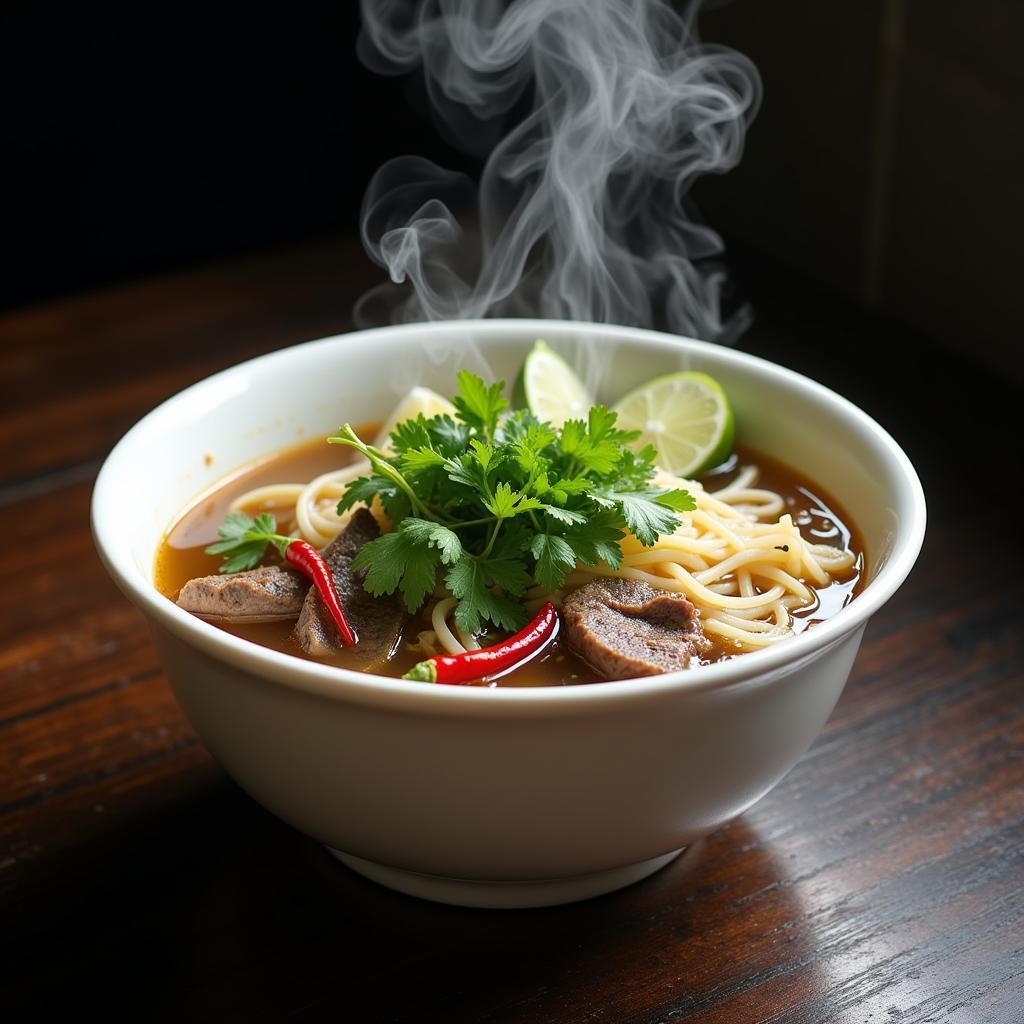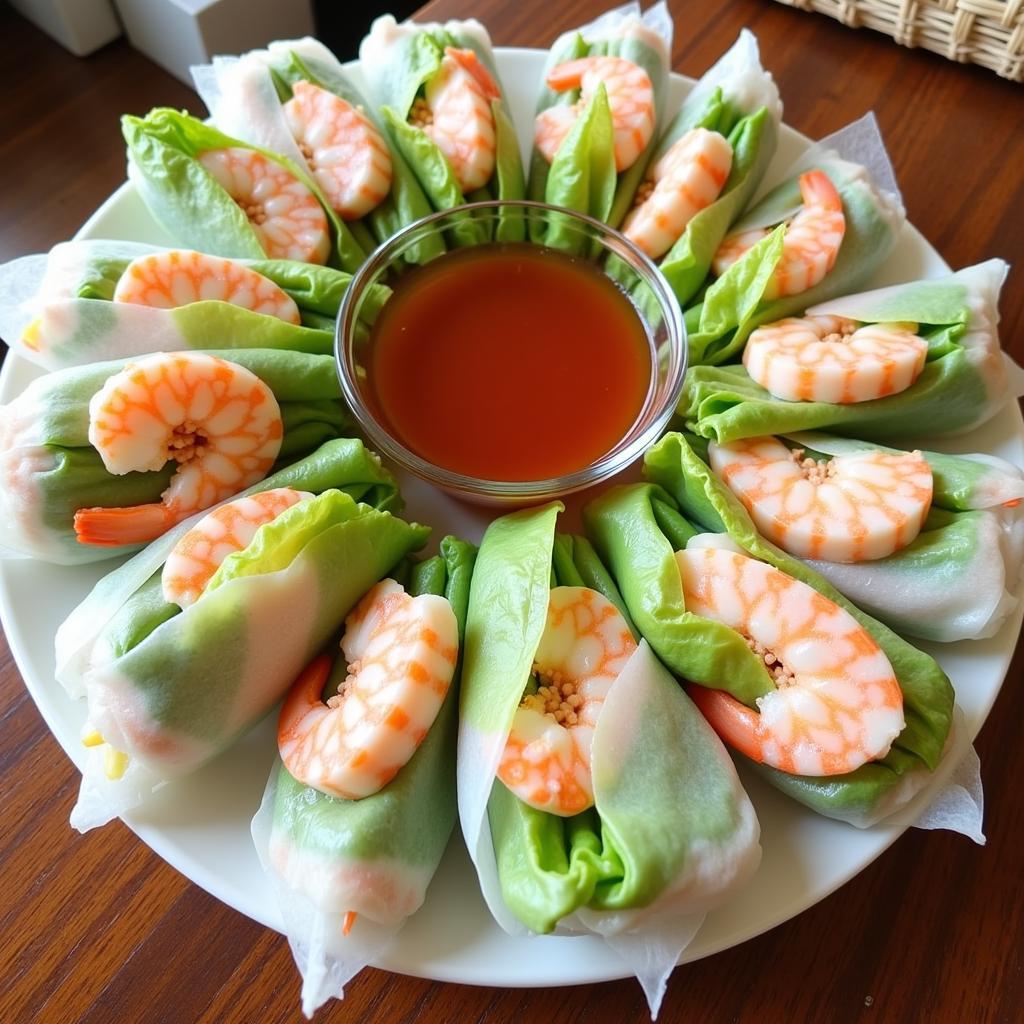Vietnamese cuisine is renowned not only for its vibrant flavors but also for its artistic presentation. The way Vietnamese food is arranged is a testament to the culture’s deep appreciation for aesthetics and balance, transforming every meal into a delightful sensory experience. From the colorful array of fresh herbs to the careful placement of ingredients, Vietnamese food presentation elevates dining to an art form.
Unveiling the Secrets Behind Vietnamese Food Presentation
The principles of Vietnamese food presentation are rooted in the philosophy of harmony and balance, reflecting the country’s rich cultural heritage. Every dish is a miniature landscape, carefully composed to engage all the senses. Color, texture, and aroma play crucial roles in creating a visually appealing and appetizing presentation.
- Emphasis on Freshness: Vibrant colors from fresh herbs and vegetables are a hallmark of Vietnamese cuisine. These ingredients are not merely garnishes but integral components, contributing to both the visual appeal and the flavor profile of the dish.
- Balance of Flavors: Just as the flavors in Vietnamese cuisine are balanced between sweet, sour, salty, bitter, and umami, the presentation also strives for harmony. Ingredients are arranged to create a visually pleasing contrast in colors and textures.
- Artful Arrangement: The arrangement of food on the plate is deliberate and often symbolic. For example, a dish might be arranged to resemble a flower or a natural landscape, reflecting the deep connection between Vietnamese culture and nature.
- Communal Dining: Many Vietnamese dishes are served family-style, encouraging sharing and interaction. Large platters and bowls filled with colorful ingredients create a sense of abundance and conviviality.
Exploring the Cultural Significance of Vietnamese Food Presentation
The meticulous attention to detail in Vietnamese food presentation goes beyond mere aesthetics. It is a reflection of the cultural values of respect, hospitality, and appreciation for the natural world.
- Respect for Ingredients: The careful handling and arrangement of ingredients demonstrate respect for the farmers and the land that produced them.
- Hospitality and Sharing: The communal nature of Vietnamese dining and the beautiful presentation of food are expressions of hospitality and generosity.
- Connection to Nature: The use of fresh herbs and the artistic arrangements often evoke images of nature, highlighting the strong connection between Vietnamese culture and the natural environment.
 Vietnamese Pho Presentation
Vietnamese Pho Presentation
How to Present Vietnamese Food Like a Pro
Whether you’re a seasoned chef or a home cook, you can apply these tips to elevate your Vietnamese food presentation:
- Start with Fresh Ingredients: The foundation of any great Vietnamese dish is fresh, high-quality ingredients. Choose vibrant herbs, colorful vegetables, and flavorful proteins.
- Embrace Color and Contrast: Use a variety of colors and textures to create a visually appealing dish. Think about contrasting the colors of vegetables, herbs, and proteins.
- Pay Attention to Detail: The small details make a big difference. Carefully arrange herbs and garnishes, and consider using decorative elements like carved vegetables or edible flowers.
- Consider the Plate: The plate itself can be part of the presentation. Choose plates that complement the colors and textures of the food.
- Practice Makes Perfect: Like any art form, mastering Vietnamese food presentation takes practice. Experiment with different arrangements and techniques to find what works best for you.
 Vietnamese Goi Cuon Presentation
Vietnamese Goi Cuon Presentation
Conclusion: Savoring the Beauty of Vietnamese Food Presentation
Vietnamese food presentation is more than just arranging food on a plate; it’s an art form that enhances the entire dining experience. By understanding the principles and cultural significance behind it, we can truly appreciate the beauty and artistry of Vietnamese cuisine. So, the next time you enjoy a Vietnamese meal, take a moment to savor not only the flavors but also the visual feast before you. For authentic Vietnamese experiences and convenient transportation, contact TRAVELCAR. We offer a range of services, including 16-seater, 29-seater, and 45-seater vehicle rentals for airport transfers, sightseeing tours, and more. Need assistance? Reach us at 0372960696, email us at [email protected], or visit us at 260 Cau Giay, Hanoi. Our customer service team is available 24/7.
FAQ
What are the key elements of Vietnamese food presentation?
Fresh ingredients, balanced flavors, artful arrangement, and communal dining.Why is presentation important in Vietnamese cuisine?
It reflects cultural values, enhances the dining experience, and shows respect for ingredients.How can I improve my Vietnamese food presentation skills?
Start with fresh ingredients, use color and contrast, pay attention to detail, and practice.What are some common garnishes used in Vietnamese cuisine?
Fresh herbs like cilantro, mint, and basil, as well as lime wedges and chili peppers.Where can I learn more about Vietnamese cooking and food presentation?
Cookbooks, online resources, and cooking classes are great resources.What are the traditional Vietnamese table settings like?
Often communal, with shared dishes and bowls in the center of the table.What are some examples of beautifully presented Vietnamese dishes?
Pho, Banh Xeo, Goi Cuon, and Bun Cha are just a few examples.
See other related articles on our website for more information about Vietnamese cuisine and culture. Contact TRAVELCAR for all your transportation needs in Hanoi.
